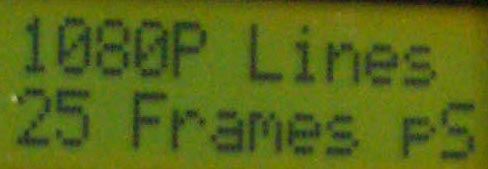HD VIDEO FORMAT READER
By: Don McClatchie
In the old days of video surveillance there was only two basic types of “SD” Standard Definition Analog video available to purchase in the USA and all of them had only 525 Vertical lines of resolution and as much as 800 Horizontal lines of Horizontal resolution. You could choose to use free running video at 59.94 frames per second or you could line lock that video to the local 60Hz power frequencies for a rate of 60 frames per second.
That was then, now there are at least 25 new HD High Definition Analog video formats available in today’s CCTV camera market and that can be a bit confusing when you are trying to match existing equipment and multiple camera types. Each of the different video formats like HD-TVI, HD-CVI, and AHD can have different numbers of vertical lines such as 1080, 720, 4MP, or 5MP and different frame rates like 12.5, 20, 25, and 30 (FPS) Frames Per Second all in various combinations.
Having so many different video formats and selections to choose from for any camera installation may seem like a good idea, but it can cause compatibility issues if new cameras are added to an existing system that are not a perfect video format match. To add to the problem many cameras have menu setups that allow for the selection of format and frame rate so just knowing the camera model in use may not help you discover the source of an incompatibility problem. Also, if the customer or anyone else has access to the camera controls they can make changes in an existing system and cause a compatibility issue.
It would be helpful to be able to measure the video signal to determine the number of vertical lines and the frame rate in use when trying to find a problem or to determine what equipment is needed to match any existing system.

FM SYSTEMS, INC is developing a meter called the HDVFR-1 a High Definition Video Format Reader that will detect the number of vertical lines and the Frames Per Second on any HD camera and display it to an LCD, it even reads “SD” Standard Definition analog NTSC, CVBS, and PAL video signals. I spoke with an installer that was putting video cameras into buses and he spent the best part of a day trying to discover why his camera pictures all of them were rolling on the monitor. It turned out that the cameras outputs were fixed on the PAL “Phase Alternating Line” format used outside the USA. A quick meter measurement could have saved him a lot of hair pulling.
The HDVFR-1 being developed is a low-cost pocket size hand-held, battery operated meter that is quick and easy to use and will read the video frame rate and number of lines of resolution of any camera type from any manufacturer. Knowing the video format used in the existing system before you purchase equipment will help you avoid delays, costly mistakes, and lost time.
Call for more information and availability at: 800-235-6960.


